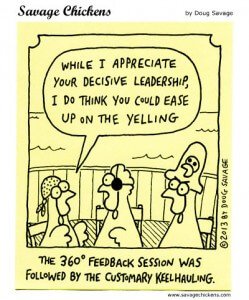 In my consulting practice, I have had the opportunity to debrief executives after they have undergone a 360 degree feedback process. In many cases, the feedback is not what the executive expected. When the feedback is positive, there is no much resistance and pretty much everybody is happy, when the feedback is negative however, it is a different animal. Knowing what is known to others and unknown to us about is the purpose of this exercise. When that information is revealed to us, sometimes it hurts, but it also instructs, if we are willing to accept the feedback and do something about it. It never seems to surprise me, however, the three most commons responses when the feedback is not what the executive was expecting.
In my consulting practice, I have had the opportunity to debrief executives after they have undergone a 360 degree feedback process. In many cases, the feedback is not what the executive expected. When the feedback is positive, there is no much resistance and pretty much everybody is happy, when the feedback is negative however, it is a different animal. Knowing what is known to others and unknown to us about is the purpose of this exercise. When that information is revealed to us, sometimes it hurts, but it also instructs, if we are willing to accept the feedback and do something about it. It never seems to surprise me, however, the three most commons responses when the feedback is not what the executive was expecting.
1.- Oh My God, I had no idea.
People in this category had no idea that the perception they were projecting was that bad. One particular leader, for example, had an “A” personality and in his mind he cared deeply for his direct reports. He wanted them to flourish and move up in the organization. When the feedback came back, it was obvious that the direct reports thought he was a “slave driver that didn’t care for them as people”. Andrew, the leader, thought he was doing them a favor, developing them by challenging them in all fronts. To his direct reports he wasn’t, he was heartless and didn’t care for their personal life. One person in particular, just had a baby and that of course changed her lifestyle, Andrew could not understand why she couldn’t stay at the office past 5:30 like the rest of her peers. In his mind, he was a great leader and developing their direct reports, from the direct report perspective, however, it wasn’t at all like that.
2.-This survey is wrong, I don’t believe this.
People in this category most likely don’t like the feedback given so they look for ways to undermine the process, the coach or the tool. Either way, they justify the feedback by looking for “holes” that will validate their way of thinking. “I don’t believe the tool, the process or the coach, therefore this must be wrong. People in this category have a hard time moving past the assessment and in many cases that is where they stay, no much change happens after the assessment. Unfortunately, these executives are sometimes, not coachable and they make little progress on their growth.
3.- I knew this was coming.
This group of people are aware of their “limitations / behaviors”, but somehow they were hoping to get better feedback. They usually reply when confronted with the results with something like “I knew I was going to get that feedback”, and they will justify in in two ways a) They are there to get me or b) That is the way I am, I can’t change.
In all three instances the tool itself can’t do much but just collect the results. The second and most important component of a 360 exercise is the follow up after the results were given. I have seen 360 exercises where the feedback is given (weather formal or informally) and it is up to the executive to follow thru and get better. Needless to say, many do not and the assessment goes in the pile of things they are hoping to get to someday, but someday never comes.
From the number of people that get their assessment, what is the percentage that accepts the feedback. From that percentage how many understand the perception they are given and decide to do something about it? How many of those actually do something about it? and finally from that group of people, how many revisit the assessment to gauge their progress? If left to the executive alone, those numbers might not be very exciting to report.
I have heard awesome comments about 360’s, unfortunately in most cases they are implemented with the expectation that they will convert any manager to a manager with an improved management effectiveness, better team and individual performance. But just learning that your cholesterol is high, for example, doesn’t ensure that you will do whatever is necessary to minimize the risks. Similarly, only through follow-up and evaluation an organization can assess if a behavior change was positive and was translated to a better management effectiveness. The best way to ensure that the executive has improved his behavior is to ask his stakeholders, or the people that are most affected by the behavior that he was trying to change.
